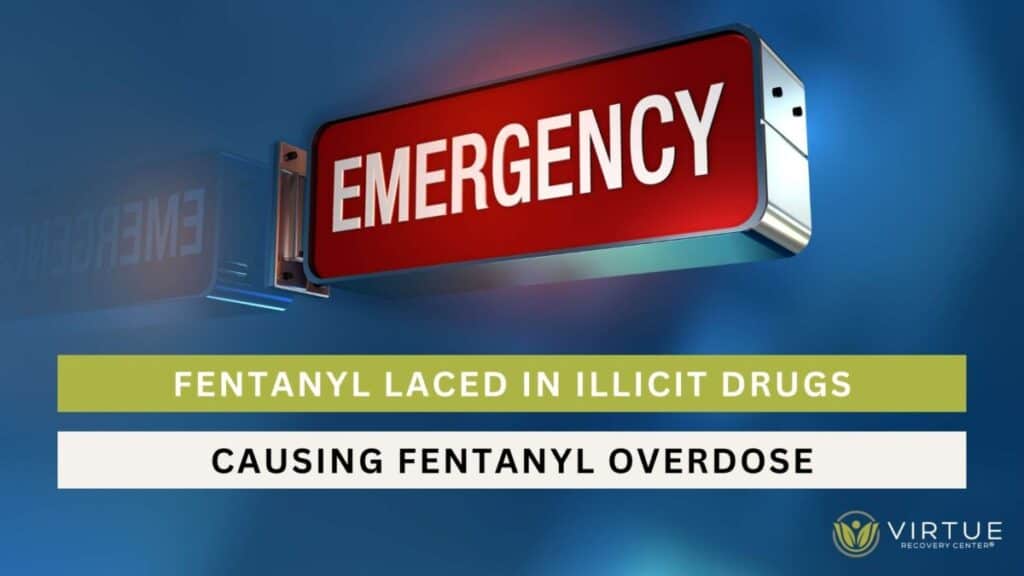Key Takeaways
- The increasing prevalence of fentanyl in illicit drugs.
- How fentanyl’s potency leads to a rise in overdose deaths.
- Recognizing the signs of a fentanyl overdose.
- Importance of fentanyl test strips and other safety measures.
- Steps to take if you or a loved one is struggling with addiction.
Introduction
The crisis of fentanyl-laced drugs is escalating, leading to a surge in overdose deaths across the nation. As a powerful synthetic opioid, fentanyl is up to 100 times more potent than morphine and has found its way into various illicit substances, significantly increasing the risk of accidental overdose. Understanding the dangers and taking preventive measures can save lives.
The Rise of Fentanyl, a Synthetic Opioid, in Illicit Drugs
Fentanyl has been increasingly detected in the illicit drug supply over the past decade. Initially used medically for pain management, fentanyl is now commonly mixed into drugs like heroin, cocaine, and marijuana by drug dealers aiming to enhance potency and addictive properties. This practice has led to a dangerous and often lethal drug landscape.
The Danger of Fentanyl’s Potency
The extreme potency of fentanyl makes it highly lethal even in minute quantities. Fentanyl is 50 to 100 times more potent than morphine, meaning that a dose as small as two milligrams can be fatal. This high potency contributes to the dramatic increase in overdose deaths, especially when individuals are unaware that their drugs are laced with fentanyl. Common drugs like heroin and cocaine are often found mixed with fentanyl, making every use a potentially deadly risk.
Marijuana Addiction
Marijuana, often perceived as a less dangerous substance, can still lead to substance abuse, particularly when used as a recreational drug. THC, the active component in marijuana, is known to be mildly addictive, and its frequent use can lead to dependence, especially in individuals who start using it at a young age. While not as severe as addiction to opioids like fentanyl or methamphetamine, marijuana addiction can still disrupt personal, professional, and social life. Treatment for marijuana addiction involves behavioral therapies and support groups to manage withdrawal symptoms and reduce the risk of relapse.
Fentanyl-Laced Marijuana
There’s always a risk with the use of illicit street drugs, such as marijuana laced with highly addictive and dangerous opioids like fentanyl, leading to a rise in deaths. This combination is particularly perilous because fentanyl is a potent opioid, similar to morphine but 50 to 100 times stronger, often found in counterfeit pills or illegally made substances. Users may unknowingly consume fentanyl when it is mixed with marijuana, increasing the risk of overdose and severe reactions like seizure or severe pain. Public health officials are concerned about the amount of fentanyl found in the drug supply, often in drugs that are not legally obtained, highlighting the dangers of using drugs from unverified sources.
Recognizing a Fentanyl Overdose
Recognizing the signs of a fentanyl overdose is crucial for timely intervention. Symptoms include severe drowsiness, slow or stopped breathing, pinpoint pupils, and loss of consciousness. Immediate administration of Narcan (naloxone), a nasal spray that can reverse opioid overdoses, can be life-saving. However, due to the potency of fentanyl, multiple doses of Narcan may be required, and emergency medical help should be sought immediately.
Safety Measures and Prevention From Drugs Containing Fentanyl
One of the most effective ways to detect the presence of fentanyl in drugs is through the use of fentanyl test strips. These strips can provide a quick and reliable indication if fentanyl is present, allowing users to make informed decisions. To reduce the risk of overdose, it’s important to never use drugs alone, to start with a small dose, and to have Narcan readily available. Public health campaigns and educational resources are vital in spreading awareness and preventing fentanyl-related deaths.
The Role of Healthcare and Law Enforcement
Healthcare providers are on the front lines of this crisis, offering treatment and support for those affected by fentanyl overdose. Medical professionals stress the importance of Narcan accessibility and the use of fentanyl test strips. Law enforcement agencies are also intensifying efforts to intercept fentanyl before it reaches the streets, aiming to dismantle the networks distributing this lethal substance. Public health policies and initiatives are crucial in reducing the prevalence of fentanyl in the drug supply and curbing the rise in overdose deaths.
Conclusion
The increasing presence of fentanyl in the illicit drug market poses a significant threat to public health. Understanding the risks, recognizing the signs of an overdose, and taking preventive measures are essential steps in combating this crisis. If you or a loved one is struggling with addiction, don’t hesitate to reach out for help. Call 254-434-6764 for assistance and support.
FAQs
What makes fentanyl so dangerous compared to other opioids?
Fentanyl is significantly more potent than other opioids, making even small amounts potentially lethal.
How can I tell if a drug is laced with fentanyl?
The most reliable way is to use fentanyl test strips, which can detect the presence of fentanyl in substances.
What should I do if someone is experiencing a fentanyl overdose?
Administer Narcan immediately and call emergency services. Multiple doses of Narcan may be needed.
Are there any ways to protect myself from accidentally ingesting fentanyl?
Avoid using drugs alone, use fentanyl test strips, and always have Narcan on hand.
How widespread is the issue of fentanyl-laced drugs?
Fentanyl-laced drugs are increasingly common, contributing to a significant rise in overdose deaths across the country.
Can laced marijuana contain fentanyl?
Yes, marijuana can be laced with dangerous substances like fentanyl, especially when obtained illegally from the street drug supply. This practice is highly risky as it mixes a recreational drug with an opioid that is similar to morphine but significantly more potent and deadly.
How can I get Naloxone (Narcan)?
Naloxone (Narcan), used to treat opioid overdose, can often be obtained from pharmacies without a prescription or through community health programs and outreach centers. It is also provided by some law enforcement agencies and is legally available in many places to ensure public access due to the rise in opioid-related deaths. Naloxone’s accessibility is crucial in combating the opioid crisis, as timely intervention can save lives in critical overdose situations. However, it is also important for individuals to be responsible with their medications and to dispose of unused medicine properly to prevent accidental ingestion or misuse. Community programs often provide guidance on safe disposal methods, helping to promote a healthier environment for everyone.
What are the limitations of fentanyl test strips?
Fentanyl test strips, while useful for detecting the presence of fentanyl in drugs like heroin, cocaine, and methamphetamine, may not detect all analogs of fentanyl, and a negative result doesn’t guarantee the substance is safe. Additionally, they require a small sample of the drug dissolved in water, which might not represent the entire substance if the fentanyl is not evenly distributed.
What drugs should I test for the presence of fentanyl?
It is advisable to test any illegally obtained drugs such as heroin, cocaine, methamphetamine, and oxycodone for the presence of fentanyl due to the increasing trend of this potent opioid being used as an additive in the illicit drug market. Fentanyl test strips can detect this dangerous substance, which is often clandestinely added to increase the drug’s potency and risk of addiction.
If fentanyl is so deadly, why do drug dealers use it to lace illicit drugs?
Drug dealers often add fentanyl to other drugs because it is extremely potent and cheap to produce, enhancing the effects of the laced drug at a lower cost. Despite its deadly risks, the addition of fentanyl can increase dependency, prompting users to return more frequently, which boosts the dealers’ profits.
Resources
https://cannabis.ny.gov/system/files/documents/2023/10/ocm_cannabisandfentanyl.pdf
https://msdh.ms.gov/page/44,25057,382.html
- About the Author
- Latest Posts
Gigi Price holds licenses as a Master Social Worker and Clinical Drug Counselor. She completed her master’s degree in Social Work at Texas State University. Over the last decade, Gigi has been dedicated to utilizing evidence-based practices to enhance patient care and treatment planning, resulting in positive, long-term outcomes for patients and their families. Her passion lies in creating a treatment environment where professionals collaborate to bring about positive change and provide a safe, trustworthy therapeutic experience. Patients can be confident in receiving top-quality care under her leadership.
In her role as the Clinical Director of Virtue Recovery Houston, Gigi conducted research to identify the most effective approaches for treating patients with acute mental health diagnoses, PTSD, and Substance Use Disorder. She then assembled a team of skilled clinicians who could offer various therapeutic modalities, such as Cognitive Behavioral Therapy (CBT), Dialectical Behavioral Therapy
(DBT), Acceptance and Commitment Therapy (ACT), Somatic Exposure, Eye Movement Desensitization and Reprocessing (EMDR), and Cognitive Processing Therapy (CPT). Gigi takes pride in overseeing the development and implementation of Virtue Houston’s Treatment Program, which includes two specialized therapeutic curricula tailored to the unique needs of individuals struggling with mental health issues, addiction, and PTSD.









